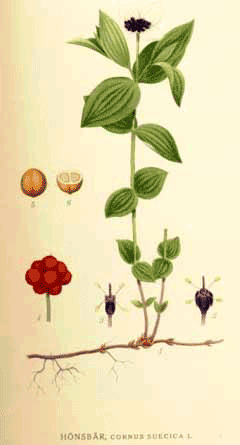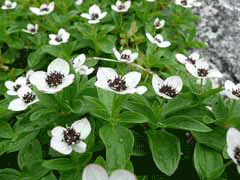 |
|
http://commons.wikimedia.org/wiki/File:Cornus_suecica.jpg |
 |
|
Translate this page:
Summary
Physical Characteristics

 Cornus suecica is a PERENNIAL growing to 0.2 m (0ft 8in) by 0.3 m (1ft).
Cornus suecica is a PERENNIAL growing to 0.2 m (0ft 8in) by 0.3 m (1ft).
See above for USDA hardiness. It is hardy to UK zone 2. It is in flower from June to July. The species is hermaphrodite (has both male and female organs) and is pollinated by Bees, flies.
Suitable for: light (sandy) and medium (loamy) soils. Suitable pH: mildly acid and neutral soils and can grow in very acid soils.
It can grow in semi-shade (light woodland) or no shade. It prefers moist soil.
UK Hardiness Map
US Hardiness Map
Synonyms
Chamaepericlymenum suecicum.
Plant Habitats
Woodland Garden Sunny Edge; Dappled Shade; Shady Edge; Ground Cover;
Edible Uses
Edible Parts: Fruit
Edible Uses:
Fruit - raw or cooked[3, 46, 61, 62, 101]. It is usually mixed with other berries[257]. Bitter and unpalatable[2]. The fruit is rich in pectin[172].
References More on Edible Uses
Medicinal Uses
Plants For A Future can not take any responsibility for any adverse effects from the use of plants. Always seek advice from a professional before using a plant medicinally.
Appetizer
The fruit is considered to be a good tonic for the appetite[4].
References More on Medicinal Uses
The Bookshop: Edible Plant Books
Our Latest books on Perennial Plants For Food Forests and Permaculture Gardens in paperback or digital formats.

Edible Tropical Plants
Food Forest Plants for Hotter Conditions: 250+ Plants For Tropical Food Forests & Permaculture Gardens.
More

Edible Temperate Plants
Plants for Your Food Forest: 500 Plants for Temperate Food Forests & Permaculture Gardens.
More

More Books
PFAF have eight books available in paperback and digital formats. Browse the shop for more information.
Shop Now
Other Uses
The fruit is rich in pectin[172]. A good ground-cover plant, succeeding under trees and shrubs[3].
Special Uses
Ground cover
References More on Other Uses
Cultivation details
Requires a moist peaty acid sandy soil[3].
References Carbon Farming Information and Carbon Sequestration Information
Temperature Converter
Type a value in the Celsius field to convert the value to Fahrenheit:
Fahrenheit:
The PFAF Bookshop
Plants For A Future have a number of books available in paperback and digital form. Book titles include Edible Plants, Edible Perennials, Edible Trees,Edible Shrubs, Woodland Gardening, and Temperate Food Forest Plants. Our new book is Food Forest Plants For Hotter Conditions (Tropical and Sub-Tropical).
Shop Now
Plant Propagation
Seed - best sown as soon as it is ripe in a cold frame or in an outdoors seedbed if there is sufficient seed[80, 113]. The seed must be separated from the fruit flesh since this contains germination inhibitors[80, 164]. Stored seed should be cold stratified for 3 - 4 months and sown as early as possible in the year[164]. Scarification may also help as may a period of warm stratification before the cold stratification[80, 164]. Germination, especially of stored seed, can be very slow, taking 18 months or more[164]. Prick out the seedlings of cold-frame sown seeds into individual pots as soon as they are large enough to handle and grow the plants on for their first winter in a greenhouse, planting out in the spring after the last expected frosts. Division in spring. This plant can be a bit temperamental when it is being divided. We have found it best to tease out small divisions from the sides of the clump, to avoid the need to disturb the main clump by digging it up. Try to ensure that each division has already produced some roots. Pot them up in light shade in a greenhouse and make sure that they are not allowed to become dry. Once they are rooting and growing away well, which might take 12 months, they can be planted out into their permanent positions.
Other Names
If available other names are mentioned here
Native Range
TEMPERATE ASIA: Russian Federation (Habarovskij kraj, Primorye, Kamcatskij kraj, Magadanskaja oblast, Sakhalin), Japan (Hokkaidô) NORTHERN AMERICA: Canada (Northwest Territories, Québec, Nova Scotia, Newfoundland and Labrador, British Columbia (northwest)), Greenland (south), United States (Alaska) EUROPE: Denmark, Finland, Faroe Islands, United Kingdom, Iceland, Norway, Sweden, Germany, Netherlands, Poland, Russian Federation (Karelia, Komi, Arkhangelsk, Neneckij avtonomnyj okrug, Leningradskaja oblast, Murmansk)
Weed Potential
Right plant wrong place. We are currently updating this section.
Please note that a plant may be invasive in one area but may not in your area so it's worth checking.
Conservation Status
IUCN Red List of Threatened Plants Status :

| Related Plants
|
| Latin Name | Common Name | Habit | Height | Hardiness | Growth | Soil | Shade | Moisture | Edible | Medicinal | Other |
| Cornus alba | Tartarian Dogwood | Shrub | 3.0 |
3-7
| F | LMH | SN | Mwe | 0 | 0 | 1 |
| Cornus alternifolia | Green Osier, Alternateleaf dogwood, Alternate Leaf Dogwood, Golden Shadows Pagoda Dogwood, Green Osi | Shrub | 6.0 |
3-8
| F | LMH | N | DM | 0 | 2 | 2 |
| Cornus amomum | Silky Dogwood | Shrub | 3.0 |
4-8
| M | LMH | SN | M | 1 | 2 | 1 |
| Cornus asperifolia drummondii | Roughleaf Dogwood | Shrub | 4.0 |
5-9
| F | LMH | N | M | 0 | 0 | 3 |
| Cornus australis | | Shrub | 4.0 |
6-9
| | LMH | SN | M | 1 | 0 | 3 |
| Cornus canadensis | Creeping Dogwood, Bunchberry dogwood, Bunchberry | Perennial | 0.3 |
2-7
| F | LMH | SN | M | 4 | 2 | 2 |
| Cornus capitata | Bentham's Cornel | Tree | 12.0 |
7-10
| M | LMH | SN | M | 4 | 1 | 3 |
| Cornus chinensis | | Tree | 10.0 |
7-10
| | LMH | SN | M | 2 | 3 | |
| Cornus controversa | Giant Dogwood, Wedding Cake Tree, | Tree | 15.0 |
5-8
| F | LMH | SN | M | 2 | 1 | 2 |
| Cornus coreana | | Tree | 20.0 |
5-9
| | LMH | SN | M | 0 | 0 | 2 |
| Cornus elliptica | | Tree | 10.0 |
7-10
| M | LMH | SN | M | 4 | 1 | 2 |
| Cornus florida | Flowering Dogwood | Shrub | 6.0 |
5-9
| M | LMH | SN | M | 2 | 2 | 3 |
| Cornus hemsleyi | | Shrub | 4.0 |
-
| | LMH | SN | M | 0 | 0 | 2 |
| Cornus hongkongensis | | Shrub | 15.0 |
-
| | LMH | SN | M | 1 | 0 | 2 |
| Cornus iberica | | Shrub | 4.0 |
-
| | LMH | SN | M | 2 | 0 | 3 |
| Cornus kousa | Japanese Dogwood, Kousa dogwood, Chinese Dogwood, | Tree | 10.0 |
5-8
| S | LMH | SN | M | 5 | 0 | 2 |
| Cornus kousa chinensis | Japanese Dogwood | Tree | 10.0 |
5-8
| | LMH | SN | M | 5 | 0 | 2 |
| Cornus macrophylla | Large-Leaf Dogwood | Tree | 15.0 |
5-9
| | LMH | SN | M | 2 | 2 | 2 |
| Cornus mas | Cornelian Cherry, Cornelian Cherry Dogwood | Shrub | 5.0 |
4-8
| M | LMH | SN | M | 4 | 2 | 3 |
| Cornus monbeigii | | Shrub | 5.0 |
6-9
| | LMH | SN | M | 1 | 2 | 2 |
| Cornus multinervosa | | Tree | 8.0 |
-
| | LMH | SN | M | 2 | 0 | 2 |
| Cornus nuttallii | Mountain Dogwood, Pacific dogwood, Western Dogwood | Tree | 10.0 |
6-8
| M | LMH | SN | DM | 1 | 2 | 3 |
| Cornus oblonga | Oblong-Petal Dogwood | Tree | 6.0 |
8-11
| | LMH | SN | M | 0 | 3 | 2 |
| Cornus occidentalis | Western Dogwood | Shrub | 6.0 |
5-9
| | LMH | SN | M | 1 | 1 | |
| Cornus officinalis | Shan Zhu Yu, Asiatic dogwood, Japanese Cornel Dogwood | Shrub | 10.0 |
5-8
| M | LMH | SN | M | 4 | 3 | 0 |
| Cornus poliophylla | | Shrub | 4.0 |
6-9
| | LMH | SN | M | 1 | 2 | 2 |
| Cornus quinquenervis | | Shrub | 3.0 |
4-8
| | LMH | SN | M | 2 | 0 | |
| Cornus rugosa | Round-Leaved Dogwood | Shrub | 3.0 |
4-8
| | LMH | SN | DM | 0 | 1 | |
| Cornus sanguinea | Dogwood, Bloodtwig dogwood | Shrub | 3.0 |
4-8
| | LMH | SN | M | 2 | 1 | 3 |
| Cornus sericea | Red Osier Dogwood, Western dogwood | Shrub | 2.5 |
2-7
| F | LMH | SN | MWe | 2 | 2 | 4 |
|
|
Growth: S = slow M = medium F = fast. Soil: L = light (sandy) M = medium H = heavy (clay). pH: A = acid N = neutral B = basic (alkaline). Shade: F = full shade S = semi-shade N = no shade. Moisture: D = dry M = Moist We = wet Wa = water.
Now available:
Food Forest Plants for Mediterranean Conditions
350+ Perennial Plants For Mediterranean and Drier Food Forests and Permaculture Gardens.
[Paperback and eBook]
This is the third in Plants For A Future's series of plant guides for food forests tailored to
specific climate zones. Following volumes on temperate and tropical ecosystems, this book focuses
on species suited to Mediterranean conditions—regions with hot, dry summers and cool, wet winters,
often facing the added challenge of climate change.
Read More
Expert comment
Author
L.
Botanical References
17200
Links / References
For a list of references used on this page please go here
Readers comment
© 2010, Plants For A Future. Plants For A Future is a charitable company limited by guarantee, registered in England and Wales. Charity No. 1057719, Company No. 3204567.